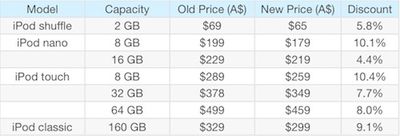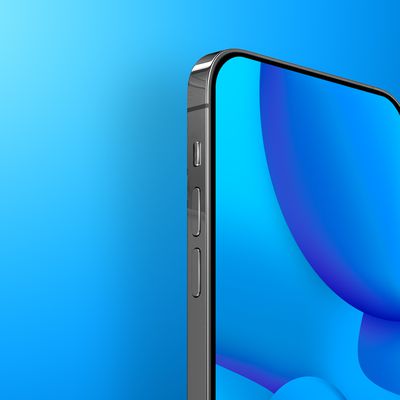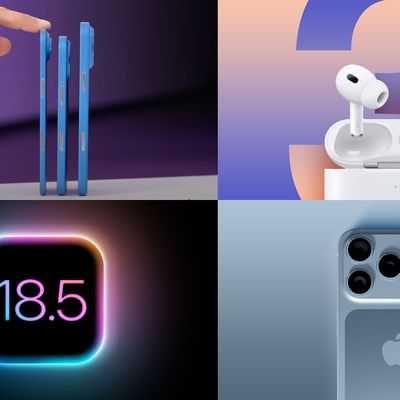Apple Lowers iPod Prices Up to 10% in Australia
Apple yesterday lowered prices on its iPod lines in its Australian online store, dropping prices as much as 10% on some models.
The Australian dollar gained strength on the U.S. dollar in the latter half of 2010, moving from a low of 81 cents in June to near parity by October. The exchange rate for the two currencies has remained near that level since that time, with the Australian actually drifting a bit higher than the U.S. dollar over the past few days. Even with the price drops and accounting for taxes built into the Australian pricing, iPod prices remain a bit higher than they are in the United States, although that is common practice for Apple as it deals with higher distribution in many of its international markets and hedges against future currency fluctuations.
Apple is usually very slow in reacting to fluctuations in exchange rates, preferring to maintain stable price points in each country and typically only changing price points in response to currency fluctuations at the time of new product introductions. Consequently, it is unclear why Apple has decided to drop its iPod pricing, and only its iPod pricing, in Australia at this time. Apple's "Back to School" rebate program offering a free iPod touch with the purchase of a Mac did just end in Australia, but the same program also ended in New Zealand and Apple did not opt to reduce pricing in that country. New Zealand's dollar has not, however, gained as much value against the U.S. dollar over the past year as has the Australian dollar.
Popular Stories
This week marks the 10th anniversary of the Apple Watch, which launched on April 24, 2015. Yesterday, we recapped features rumored for the Apple Watch Series 11, but since 2015, the Apple Watch has also branched out into the Apple Watch Ultra and the Apple Watch SE, so we thought we'd take a look at what's next for those product lines, too.
2025 Apple Watch Ultra 3
Apple didn't update the...
While the so-called "iPhone 17 Air" is not expected to launch until September, there are already plenty of rumors about the ultra-thin device.
Overall, the iPhone 17 Air sounds like a mixed bag. While the device is expected to have an impressively thin and light design, rumors indicate it will have some compromises compared to iPhone 17 Pro models, including only a single rear camera, a...
While the iPhone 17 Pro and iPhone 17 Pro Max are not expected to launch until September, there are already plenty of rumors about the devices.
Below, we recap key changes rumored for the iPhone 17 Pro models as of April 2025:
Aluminum frame: iPhone 17 Pro models are rumored to have an aluminum frame, whereas the iPhone 15 Pro and iPhone 16 Pro models have a titanium frame, and the iPhone ...
Apple has completed Engineering Validation Testing (EVT) for at least one iPhone 17 model, according to a paywalled preview of an upcoming DigiTimes report.
iPhone 17 Air mockup based on rumored design
The EVT stage involves Apple testing iPhone 17 prototypes to ensure the hardware works as expected. There are still DVT (Design Validation Test) and PVT (Production Validation Test) stages to...
Apple may have canceled the super scratch resistant anti-reflective display coating that it planned to use for the iPhone 17 Pro models, according to a source with reliable information that spoke to MacRumors.
Last spring, Weibo leaker Instant Digital suggested Apple was working on a new anti-reflective display layer that was more scratch resistant than the Ceramic Shield. We haven't heard...
Apple will likely manufacture its 20th anniversary iPhone models in China, despite broader efforts to shift production to India, according to Bloomberg's Mark Gurman.
In 2027, Apple is planning a "major shake-up" for the iPhone lineup to mark two decades since the original model launched. Gurman's previous reporting indicates the company will introduce a foldable iPhone alongside a "bold"...
We've known for quite some time about Apple's plans for a thinner "iPhone 17 Air" coming later this year, but wow, the latest dummy models give us our best look yet at just how thin this phone is going to be.
Other Apple news and rumors this week included another iOS 18.5 beta, the 10th anniversary of the Apple Watch launch, and more management reshuffling in Apple's Siri division, so read...





















